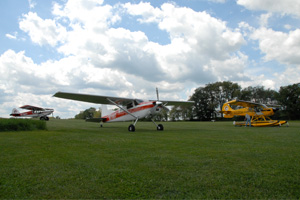The Dream Boat – It Flies
LAKE ARTHUR, Pa. — Boys love their toys. Dan Marks, 50, of Portersville, Pa., is unabashedly unapologetic about his. He’s been to Alaska on seven hunting trips, bagging two brown bears, one record-breaking Alaska Yukon moose, a bighorn Dall sheep and a mountain goat. In his hangar, he has a big-ass Cobalt powerboat parked next to his three airplanes. He bought his 85-acre farm seven years ago. A neighbor farms it; Dan mostly wanted the 1,400-ft. grass landing strip.
His latest plane is a nine-year-old Husky A-1B float plane, built by Aviat Aircraft Inc. Dan, a private pilot for about 25 years, fell in love with float planes on his Alaskan trips. He took some lessons, earned the added rating two years ago and started shopping for one of his own.
If the gear’s down on a water landing, It’ll flip you over in a heartbeat.
These are the type of planes they use in Alaska for getting into short fields, onto river bars and to land in small ponds and stuff – to get closer to the game,” he says. “I bought this one used in Amarillo, Texas, and flew it back on wheel gear.” That means the floats were removed; the A-1B has retractable landing gear. But remember: For water landings, keep those wheels raised! “If the gear’s down (on a water landing), it’s major trouble,” he says. “It’ll flip you over in a heartbeat.”
On approach for landing on water, the pilot does a fly-by to look for rocks, debris, boats – anything on the water.
On a recent flight – after he made sure the gear was up – Dan set the plane down on the Allegheny River, taxied to the dock and waded in to tie down the plane. (Don’t wear dress shoes for this.)
Is landing on water dangerous? About like landing any other plane, Dan says – unless the water is glassy.”It’s like a mirror,” he says. “You can’t really judge how close you are to the surface.
You have to land as close to shore as you can and use something else as a reference instead of the water.” The Allegheny isn’t often glassy, but Pennsylvania is less than ideal for float planes.
Most state-owned lakes make pilots jump through hoops for permission to land.
Most state-owned lakes either don’t permit them or make pilots jump through hoops for permission. Many of the rivers are too shallow. “And you have wires crossing over from one mountainside across the river to the other side,” Dan adds.
From his farm, which is about 40 miles from Pittsburgh, he often hops over to Ohio, where he can do takeoffs and landings on a friend’s lake.
Dan, a building contractor, started flying about a year after his father got a pilot’s license. Al Marks would take his wife and son up in his Cessna, and Dan would sometimes take the controls. Soon, he was borrowing the plane for his own lessons.
Dan loves the independence and challenge of flying; he especially enjoys seeing fall foliage from the air. His hangar is also home to another Husky (without floats) and a four-place Cessna 185. He often flies with Molly, a 4-year-old yellow lab.
— A former Reuters reporter, Zimmerman teaches part-time at Kent State, Cuyahoga Community College and Lakeland Community College.“I loved working on ‘Stories That Fly.’ I’ve always loved aviation — I hardly ever miss the Cleveland National Air Show. It’s in my genes — my mom used to tell me stories about the old Cleveland Air Races, and I have a great photo of her, probably from the 1930s, standing on the grounds of the old Goodyear Airdock.”
Rate this story! Click a star below to let us know what you think. 1 is low, 10 is high.


Sorry, the comment form is closed at this time.